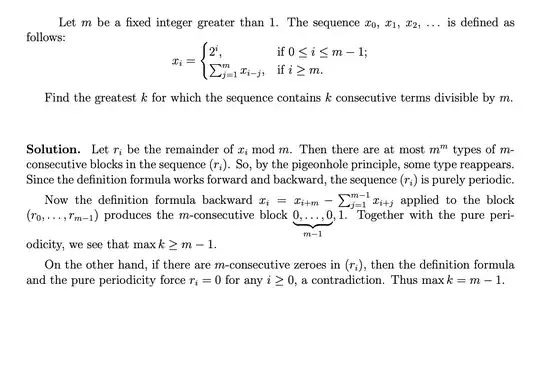Both parts hinge on the fact that the recursion formula can be used forwards (given $x_{i+1}, x_{i+2}, \ldots ,x_{i+m}$, you can calculate $x_{i+m+1}$), which is the usual way, and backwards (given $x_{i+1}, x_{i+2}, \ldots ,x_{i+m}$, you can calculate $x_{i}$, by the formula given in the solution: $x_i=x_{i+m} - \sum_{j=1}^{m-1}x_{i+j}$).
So for 1. lets assume you have 2 identical remainder subsequences of length $m$, starting at indices $a < b$:
$$\forall j\in \{0,1,\ldots,m-1\}: r_{a+j}=r_{b+j}.$$
That's the periodic part. Because the backwards formula $x_i=x_{i+m} - \sum_{j=1}^{m-1}x_{i+j}$ does not use any division, it also applies to the remainders $r_i$. From that follows that $r_{a-1}=r_{b-1}$, because if you set $i=a-1$ and $i=b-1$ respectively in the backwards formula, you get the same values on the right hand side in each case.
That means the pair $(a,b)$ you started with as a "witness" to the periodicity of remainders subsequences of length $m$ is not the first such pair, $(a-1, b-1)$ is as well. And that goes on and on, until you finally stop at the "witness" $(0,b-a)$, which says that the subsequences of length $m$ are purely periodic.
For 2., we again use the fact that we can calculate remainders forwards and backwards. We know from 1. that at some index $d=b-a$ we have
$$\forall j\in \{0,1,\ldots,m-1\}: r_{j}=r_{d+j}.$$
What is $r_{d-1}$? We can calculate it by the backwards formula.
$$r_{d-1} \equiv r_{d-1+m} - \sum_{j=1}^{m-1}r_{d-1+j}\mod {m}$$
$$r_{d-1} \equiv r_{m-1} - \sum_{j=1}^{m-1}r_{j-1}\mod {m}$$
$$r_{d-1} \equiv x_{m-1} - \sum_{j=1}^{m-1}x_{j-1}\mod {m}$$
$$x_{m-1} - \sum_{j=1}^{m-1}x_{j-1} = 2^{m-1} - \sum_{j=1}^{m-1}2^{j-1}=1,$$
so we get $r_{d-1}=1$. The same way we get that $r_{d-m}=\ldots=r_{d-2}=0$.
From a general point, once you know that your recursion formula works forwards and backwards even with remainders, you can think of the sequence being infinite in both directions, existing for negative indices as well. Then you can calculate $r_{-1}, r_{-2}$ a.s.o. from the values $r_0,r_1$,a.s.o. That's what we did above, and we know that those remainders will come up in the actual seqeunce that has positive indices after the perdiod is over.
